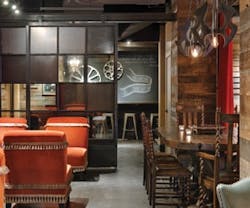Breaking the Mold
Just about anyone who's stepped into a local Starbucks store (or even heard of the brand) is probably aware of the company's commitment to fair trade practices with its coffee suppliers in developing countries around the world. Indeed, it may be one of the most prominent reasons for Starbucks' astonishing growth and success over the years.
What some may not know, however, is that its corporate social responsibility runs deeper than purchasing beans from organic farms and paying laborers in developing countries a fair wage—it also extends to the environment from which the company harvests its crops, and now, to the stores in which people enjoy its products.
A brimming example of the company's environmental commitment can be seen in the newly designed Roy Street Coffee & Tea in Seattle, which is currently registered for LEED® (Leadership in Energy and Environmental Design) certification, and is the second Starbucks to open as part of the U.S. Green Building Council's LEED Volume Certification pilot program. Over the next six months, Starbucks will build or renovate a minimum of 10 pilot stores in six different bioregions around the world. This effort will help the company reach its goal of achieving LEED certification for all new company-owned stores worldwide, beginning in late 2010.
The new Roy Street location draws design inspiration from the surrounding performing arts culture and features locally sourced, reused and recycled materials that are one-of-a-kind. What immediately strikes you about Roy Street is that it is not an out-of-the box design that you might expect from a massive corporate chain. Rather, under the direction of CEO Howard Schultz, Starbucks encouraged its store designers to break the mold of its traditional chain outlets and create a retail space that blends into the community it serves.
According to an official Starbucks release, "Roy Street Coffee & Tea gives customers new opportunities for discovery, a high level of interaction, and a deep connection to the local community." For example, in addition to enjoying their favorite latte, customers can also experience regular film screenings, musical performances, literary readings, and student art exhibitions. Additionally, private and semi-private spaces are available throughout the store for work and social meetings.
More than half the furnishings in the Roy Street store are reused. Salvaged doors refinished by local artists welcome customers while residential molding and wooden shipping crates add visual interest as a wall treatment. Hardwood flooring from a Starbucks headquarters clads a bar topped with reclaimed stone. A sliding door made from a warehouse window serves as a partition for a private room, and antique furniture used throughout the space is inviting while salvaged barn wood warms up the walls.
Other locally sourced, reused and recycled elements include:
- Front doors that were salvaged (and once appeared on a movie set)
- Wood materials locally sourced and repurposed from architectural salvage yards, an area barn, shipping crates, a wind-fallen tree, and timber from the previous space
- Much of the furniture was sourced from local vintage antique stores, and was refinished and repurposed, including reupholstered soft seating retired from other Starbucks locations
- Many of the light fixtures were created by local artists; others were found in area salvage shops and rewired or refinished
- The bar was built using slate from nearby Garfield High School and steel from a local shipyard
- The steel table was found in a metal shop; one large wooden table was crafted using wood decking from an old ship
- Many of the building elements contain recycled material, including the insulation which was made from a combination of rapidly renewable materials and post-consumer recycled glass
- Low-flow faucets and toilets reduce water use by 30 percent
- LED lamps reduce lighting energy use by 45 percent
- Low or no VOC paints, finishes and adhesives were used throughout the space
The end result is a beautifully eclectic, locally-inspired space that invites customers to relax with their favorite cup of coffee—and a clear conscience.
